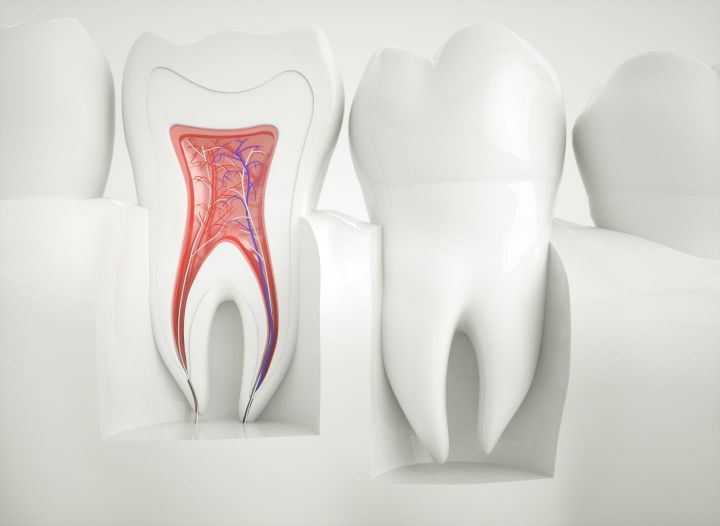Root Canals
A root canal is a treatment used to repair and save a tooth that is badly decayed or becomes infected. During a root canal procedure, the nerve and pulp are removed, and the inside of the tooth is cleaned and sealed. Without treatment, the tissue surrounding the tooth will become infected, and abscesses may form. A tooth’s nerve is not vitally important to a tooth’s health and function after the tooth has emerged through the gums. Its only function is to provide the sensation of being hot or cold. The presence or absence of a nerve will not affect the day-to-day functioning of the tooth.

Frequently Asked Questions
What is a root canal?
A root canal is a treatment used to repair and save a tooth that is badly decayed or becomes infected. During a root canal procedure, the nerve and pulp are removed, and the inside of the tooth is cleaned and sealed. Without treatment, the tissue surrounding the tooth will become infected, and abscesses may form.
“Root canal” is the term used to describe the natural cavity within the center of the tooth. The pulp, or pulp chamber, is the soft area within the root canal. The tooth’s nerve lies within the root canal.
A tooth’s nerve is not vitally important to a tooth’s health and function after the tooth has emerged through the gums. Its only function is sensory—to provide the sensation of hot or cold. The presence or absence of a nerve will not affect the day-to-day functioning of the tooth.
What are the signs a root canal is needed
Sometimes no symptoms are present; however, signs you may need a root canal include:
- Severe toothache pain upon chewing or application of pressure
- Prolonged sensitivity/pain to heat or cold temperatures (after the heat or cold has been removed)
- Discoloration (a darkening) of the tooth
- Swelling and tenderness in the nearby gums
- A persistent or recurring pimple on the gums
What happens during a root canal?
A root canal requires one or more office visits. The first step in the procedure is to take an X-ray to see the shape of the root canals and determine if there are any signs of infection in the surrounding bone. Your dentist will then use local anesthesia to numb the area near the tooth. Anesthesia may not be necessary since the nerve is dead, but most dentists still anesthetize the area to make the patient more relaxed and at ease.
Next, to keep the area dry and free of saliva during treatment, your dentist will place a rubber dam (a sheet of rubber) around the tooth.
An access hole will then be drilled into the tooth. The pulp, along with bacteria, decayed nerve tissue, and related debris, are removed from the tooth. The cleaning out process is accomplished using root canal files. A series of these files of increasing diameter are each subsequently placed into the access hole and worked down the full length of the tooth to scrape and scrub the sides of the root canals. Water or sodium hypochlorite is used periodically to flush away the debris.
Once the tooth is thoroughly cleaned, it is sealed. Some dentists like to wait a week before sealing the tooth. For instance, if there is an infection, your dentist may put medication inside the tooth to clear it up. Others may choose to seal the tooth the same day it is cleaned out. If the root canal is not completed on the same day, a temporary filling is placed in the exterior hole in the tooth to keep out contaminants, like saliva and food, between appointments.
At the next appointment, to fill the interior of the tooth, a sealer paste and a rubber compound called gutta percha are placed into the tooth’s root canal. To fill the exterior access hole created at the beginning of treatment, a filling is placed.
The final step may involve further restoration of the tooth. Because a tooth that needs a root canal often has a large filling, extensive decay, or other weakness, a crown, crown and post, or other restoration often needs to be placed on the tooth to protect it, prevent it from breaking, and restore it to full function. Your dentist will discuss the need for any additional dental work with you.
How painful is a root canal?
Root canal procedures have the reputation of being painful. Actually, most people report that the procedure itself is no more painful than having a filling placed.
How successful is a root canal?
Root canal treatment is highly successful; the procedure has more than a 95% success rate. Many teeth fixed with a root canal can last a lifetime. Also, because the final step of the root canal procedure is the application of a restoration such as a crown or filling, it will not be obvious to onlookers that a root canal was performed.



LOCATION
4605 Buena Vista Rd Suite 660
Bakersfield, CA 93311
Hours: Mon / Tues / Thurs 8-5pm
Wednesday 9-6pm
Friday (by appointment)
CONTACT
(661) 454-7600
[email protected]

